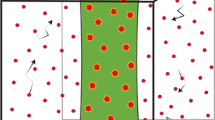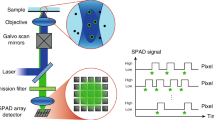Abstract
An epi-illuminated microscope configuration for use in fluorescence correlation spectroscopy in bulk solutions has been analyzed. For determining the effective sample dimensions the spatial distribution of the molecule detection efficiency has been computed and conditions for achieving quasi-cylindrical sample shape have been derived. Model experiments on translational diffusion of rhodamine 6G have been carried out using strong focusing of the laser beam, small pinhole size and an avalanche photodiode in single photon counting mode as the detector. A considerable decrease in background light intensity and measurement time has been observed. The background light is 40 times weaker than the fluorescence signal from one molecule of Rh6G, and the correlation function with signal-to-noise ratio of 150 can be collected in 1 second. The effect of the shape of the sample volume on the autocorrelation function has been discussed.
Similar content being viewed by others
References
Aragón SR, Pecora R (1976) Fluorescence correlation spectroscopy as a probe of molecular dynamics. J Chem Phys 64:1791–1803
Ehrenberg M, Rigler R (1974) Rotational brownian motion and fluorescence intensity fluctuations. Chem Phys 4:390–401
Elson EL, Magde D (1974) Fluorescence correlation spectroscopy. I. Conceptual basis and theory. Biopolymers 13:1–27
Koppel DE (1974) Statistical accuracy in fluorescence correlation spectroscopy. Phys Rev A 10:1938–1945
Koppel DE, Axelrod D, Schlessinger J, Elson EL, Webb WW (1976) Dynamics of fluorescence marker concentration as a probe of mobility. Biophys J 16:1315–1329
Marquardt DW (1963) An algorithm for least-squares estimation of non-linear parameters. J Soc Ind Appl Math 11:431–441
Palmer III AG, Thompson NL (1989) Optical spatial intensity profiles for high order autocorrelation in fluorescence spectroscopy. Appl Opt 28:1214–1220
Qian H, Elson EL (1991) Analysis of confocal laser-microscope optics for 3-D fluorescence correlation spectroscopy. Appl Opt 30:1185–1195
Rigler R, Widengren J (1990) Ultrasensitive detection of single molecules by fluorescence correlation spectroscopy. Bioscience 3:180–183
Rigler R, Mets Ü (1993) Diffusion of single molecules through a Gaussian laser beam. SPIE Proceedings. Laser Applications in Life Sciences. Sept. 1992 Jyväskylä, Finland (in press)
Rigler R, Widengren J, Mets Ü (1992) Interactions and kinetics of single molecules as observed by fluorescence correlation spectroscopy. In: Wolfbeis OS (ed) Fluorescence spectroscopy. New methods and applications. Springer, Berlin Heidelberg New York, pp 13–24
Schneider MB, Webb WW (1981) Measurement of submicron laser beam radii. Appl Opt 20:1382–1388
Author information
Authors and Affiliations
Additional information
Correspondence to: R. Rigler
Rights and permissions
About this article
Cite this article
Rigler, R., Mets, Ü., Widengren, J. et al. Fluorescence correlation spectroscopy with high count rate and low background: analysis of translational diffusion. Eur Biophys J 22, 169–175 (1993). https://doi.org/10.1007/BF00185777
Received:
Accepted:
Issue Date:
DOI: https://doi.org/10.1007/BF00185777




